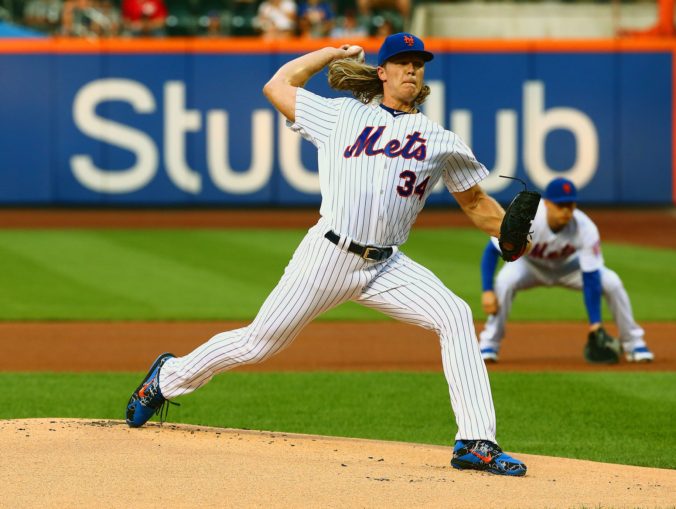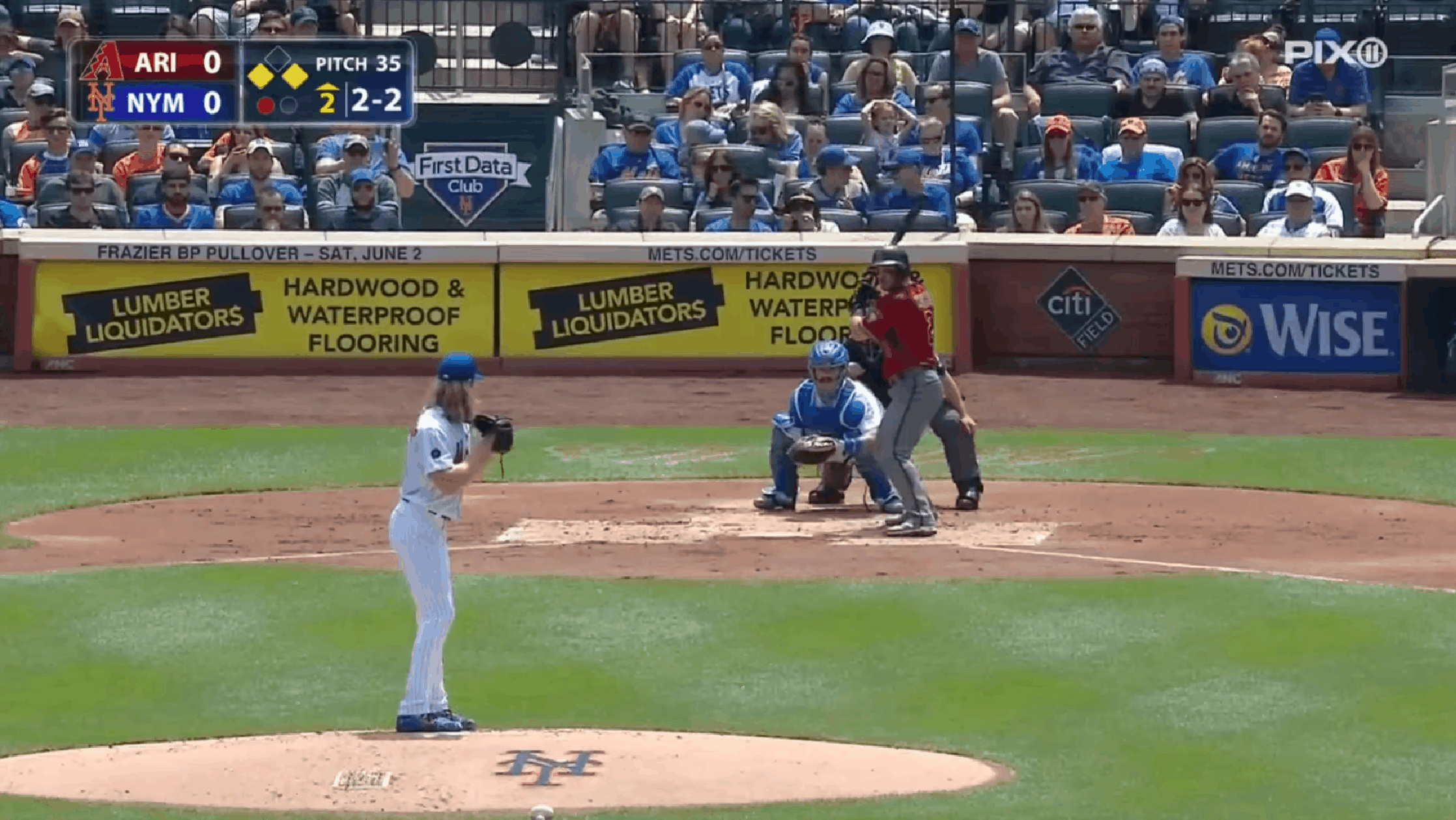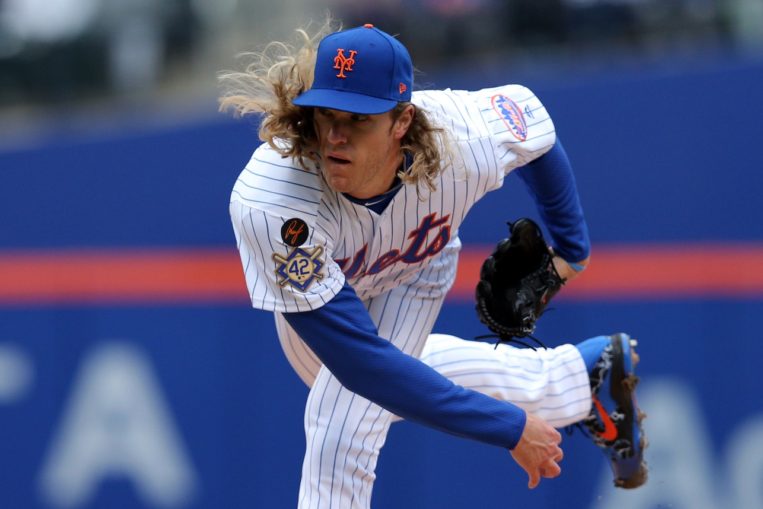
Stunning as it may be, but Noah Syndergaard has been an afterthought for much of this season. After bursting onto the scene in 2015 and putting up a Cy Young caliber 2016, Syndergaard has missed significant time with injury both this and last season, and thus spent some time out of the spotlight. But he’s still been an excellent pitcher, and with the guidance of new pitching coach Dave Eiland, Thor might be getting even better.
In an article for Rotographs earlier this season, Nick Pollack discussed Syndergaard’s biggest flaw – balls in play. Syndergaard has consistently run an above-average batting average on balls in play (BABIP), a career .318 figure and 11th highest in the MLB among qualified starters since 2015. Pollack points to Syndergaard’s fastball placement – Syndergaard tends to leave his fastballs on the outside for hitters to punish. Looking at his four-seamer placement, it’s a very obvious trend against RHH, and at least noticeable against LHH.

No matter how hard Syndergaard throws his fastball, a fastball on the outside corner gives a hitter an opportunity to punish it the other way. Pollack’s argument is that Syndergaard is placing his fastball right in the swing plane of hitters. If he’s not blowing the pitch by hitters, he’s getting hit hard – on zone fastballs outside against righties from 2015-2017, Syndergaard has an average exit velocity allowed of 93.2 MPH, well above average (league average exit velocity on fastballs is 88.5 MPH). It’s less of a problem against lefties (89.5 MPH), but the fact remains that Syndergaard has usually been torched on the outside fastball.
Enter Dave Eiland. Eiland, the pitching coach for the Kansas City Royals for so many years, joined the Mets in the same role this offseason as a part of a sweeping management overhaul. Eiland was very clear about his goal as pitching coach: in an article by the New York Post’s Kevin Kernan, Eiland said, “There is one stat I hope we lead the league in, and that’s hit batters… not because we are trying to hit guys, we’re not head-hunting. It’s because we are pitching them off the plate.”
Quietly, Syndergaard has been taking Eiland’s advice. Here are Syndergaard’s plate-x figures for his four-seamer (plate-x is where a pitch is placed relative to the center of the plate – a lower x means that it’s closer to the left of the plate from the catcher’s view, a higher x means that it’s closer to the right):
| Year | Avg. Plate X (RHH) | Avg. Plate X (LHH) |
|---|---|---|
| 2015 | 0.14 | -0.04 |
| 2016 | 0.13 | -0.06 |
| 2017 | 0.03 | 0.06 |
| 2018 | -0.11 | 0.13 |
Syndergaard has not been throwing his four-seamer as often as he used to (he’s been leaning more heavily on his sinker), but on average, his four-seamer is now located more inside than outside for both LHH and RHH. Syndergaard’s sinker has also gradually shifted more inside to hitters, albeit to a lesser degree.
| Year | Avg. Plate X (RHH) | Avg. Plate X (LHH) |
|---|---|---|
| 2015 | -0.22 | -0.53 |
| 2016 | -0.17 | -0.58 |
| 2017 | -0.24 | -0.1 |
| 2018 | -0.27 | -0.37 |
Why, as a pitcher, do you want to throw inside more? Throwing inside to hitters allows you to jam them – either they anticipate it and get the bat around in time to pull a pitch over, or they make weak contact off the inside part of the bat. Jamming hitters prevents them from putting the barrel on the bat unless they can catch up to it – and nobody is catching up to Syndergaard, one of the fastest starters in the MLB – look at how early Jeff Mathis has to swing here to even make contact with Syndergaard.

But there’s one glaring flaw with all this: Syndergaard’s BABIP this season (.339) is roughly the same as his BABIP from 2016-2017 (.335). We’re seeing the change, but Syndergaard hasn’t seen the results that we’d expect.
Or maybe he has. Per Sports Info Solutions, Syndergaard leads the majors in fewest % of at-bats ending in hard contact this season, at just 17%. His hard-hit rate of 22.4% also leads the majors among pitchers with at least 80 IP (according to FanGraphs). Minimum 1250 pitches, Syndergaard has the second lowest barrel rate in the MLB at just 2.8%, the best figure of his career.
Batted balls in play can be fluky for pitchers to a degree. In 2018, Syndergaard is running an xBA on his four-seamer of .282 and .263 on his sinker, but a BA of .304 and .276 on the pitches respectively according to Statcast, which may indicate that Syndergaard is seeing some bad luck on balls in play with his fastball. The Mets’ atrocious defense this season hasn’t helped matters much: the Mets are second-to-last in the MLB in defensive runs saved and ultimate zone rating, just behind the Orioles.
Still, Syndergaard looks to be adjusting with Eiland’s guidance. Syndergaard, already a top-tier starter with incredible strikeout stuff, is changing up his approach even further to cut down on solid contact – Thor looks like he’s taking another step towards dominance, even if the results haven’t followed quite yet.















